|
|

This chapter provides instructions for installing Cisco 15200 units, which include assembled-to-order Cisco 15252 Mulitchannel Units (MCUs) and individual MCU components, and assembled-to-order ONS 15201 Single-Channel Units (SCUs) and individual SCU components. This chapter also explains how to install a new channel on an MCU and how to link multiple nodes to accommodate additional traffic.
 |
Note The instructions in this section primarily address the installation of the ONS 15252 MCUs, ONS 15201 SCUs, and modules supplied by Cisco Systems. Installation of racks, electrical wiring, raceways, and other equipment not covered in this manual should follow all local, state, federal, or international (if applicable) codes and regulations. |
You should be thoroughly familiar with the instructions in this manual before starting any work. Use the following general order of work when installing a site:
Step 2 When you arrive at the site, first verify the ONS 15200 equipment according to the procedures in "Pre-Installation Procedures." If there is a problem with the equipment, contact the Cisco Technical Assistance Center (TAC) at 1-877-323-7368.
Step 3 If you do not install the equipment when it arrives, store as specified in "Pre-Installation Procedures."
Step 4 Unpack equipment only after preparing the site as described in "Pre-Installation Procedures."
Step 5 When installing equipment at a site, follow the procedures in this chapter in the order presented.
Step 6 Turn up and test the ONS 15200 system as described in "Turn Up and Test."
Step 7 Make connections using the information in "Connectors and Cabling."
Based on the system to be installed, determine the size, number, and location of racks, as well as the MCUs and SCUs required. The MCUs and SCUs will fit in 485 mm (19-in.) equipment racks. The racks must be accessible from the front and rear for equipment installation.
 |
Note If you do not have rear access to the equipment, you must install the ground and power on the equipment before mounting the equipment in a rack. |
Plan rack and unit installation based on the following considerations:
To install an ONS 15200 system, customary installation and electrical tools are required. The following items are also required:
Chapter 4 lists the items required for turn up and test.
When installing ONS 15200 equipment into racks, follow these guidelines:
Figure 3-1 shows the outer dimensions of the ONS 15200 system equipment.

It is vital that the ONS 15252 MCU, ONS 15252 fan unit, and ONS 15201 SCU are properly grounded. The grounding points on the ONS 15200 units are located as follows:
 |
Note A ground strip (P/N 72-2755) 30 cm (11.8 in.) long is supplied with the equipment in the ONS 15252 MCU accessory kit (P/N 53-1678) or the ONS 15201 SCU accessory kit (P/N 53-1679). |
The location of the grounding points on the MCU and SCU is shown in Figure 3-2. The location of the fan unit grounding points is shown in Figure 3-3.
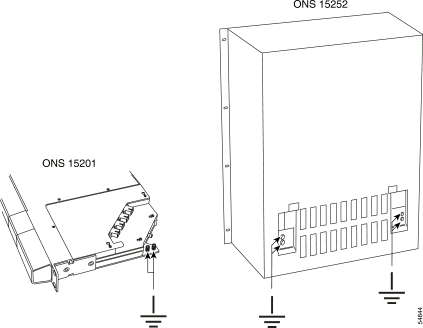

The ONS 15252 MCU, ONS 15252 fan unit, and ONS 15201 SCU can be powered with a regular telecommunication power supply of -48 VDC (and 0 VDC return). AC powering can be made from the regular power grid, at both 115 VAC and 230 VAC, through the use of AC-to-DC power converters. Two independent power supplies can be attached to the ONS 15200 equipment. If two different supplies are used, they should be independently powered.
 |
Caution The AC cord which can be ordered for the SCU is not to be used in cable management devices such as wiring ducts, plenums, or risers. For such applications, an approved AC power cord must be provided by the customer. At minimum, the AC power cord must meet all National Electrical Code (NFPA 70, National Electrical Code, 2000 Edition) standards and all local building code requirements. This applies to Central Offices and other buildings. |
Two versions of the ONS 15252 MCU mechanical shelf exist: Release 1.0 and Release 1.01. Cisco currently ships only the Release 1.0.1 shelf and no longer ships the Release 1.0 shelf.
The Release 1.0.1 shelf includes a baffle. The baffle is a partially-perforated, angled metal plate that is mounted below and behind the metal support beam and is mechanically attached to the back of the shelf. It runs the width of the shelf. To view the baffle, look up through the ventilation cavities at the back of the shelf.
The ONS 15252 Release 1.01 includes a fan unit. Before using the Release 1.01 shelf, you must install the fan unit. Do not use the fan unit with a Release 1.0 shelf. See the Cisco ONS 15200 Product Description for more information about the fan unit.
 |
Caution You must install the fan unit in a Release 1.01 shelf. Running the Release 1.01 shelf without the fan unit may result in equipment damage. |
 |
Caution Do not install the fan unit in a Release 1.0 shelf. Running the Release 1.0 shelf with a fan unit may result in equipment damage. |
The ONS 15252 Release 1.01 includes an updated Network Adaptation Module (NAM). The Release 1.01 NAM is designated with a "N3"label on the faceplate, whereas the previous version of the NAM does not have a faceplate label. The Release 1.01 shelf requires the Release 1.01 NAM. You can also use Release 1.01 NAMs in the Release 1.0 shelf. See the Cisco ONS 15200 Module Handbook for more information about the NAM.
 |
Caution Placing NAMs without the N3 label into an Release 1.01 shelf may result in equipment damage. |
Use the following procedures to install an assembled-to-order (ATO) ONS 15252 MCU. Prior to installing an MCU in an equipment rack, verify that 13 rack units (622 mm [24.5 in.]) of space is available. The lower portion of the MCU is the passive optical shelf.
The ATO MCU contains a Release 1.01 shelf. See "Shelf Version Considerations" section.
 |
Note You can install the ground and power cables before mounting the MCU. See the "Install the ONS 15252 MCU Ground Cable" section and the "Connect the ONS 15252 MCU A-side and B-side Power Connections to the PDP" section for more information. |
 |
Caution During the ONS 15252 MCU installation, two people are required to lift and hold the unit in position. |

Step 2 Lift and align the MCU with the equipment rack and cage nuts. The mounting holes in the MCU should align with the cage nuts.
Step 3 Attach the MCU to the equipment rack with eight screws (M6 or UNC 12-24).
Step 2 Locate the three left-side crossbeam mounting screws.
Step 3 Use a Phillips screwdriver to remove the crossbeam mounting screws from the left side.
Step 4 Locate the three crossbeam mounting screws on the right side.
Step 5 Use a Phillips screwdriver to remove the crossbeam mounting screws from the right side.
Step 6 When the left- and right-side crossbeam mounting screws are removed, lift and remove the crossbeam from the passive optical shelf door.
 |
Note Keep the transport crossbeam and the screws stored in a safe location for possible retrieval and reinstallation in case the equipment is moved to another location. |
You must install a fan unit in the equipment rack above each ONS 15252 MCU.
 |
Caution You must install the fan unit in a Release 1.01 shelf. Running the Release 1.01 shelf without the fan unit may result in equipment damage. For more information about shelf versions, see "Shelf Version Considerations" section. |
 |
Caution Do not install the fan unit in a Release 1.0 shelf. Running the Release 1.0 shelf with a fan unit may result in equipment damage. For more information about shelf versions, see "Shelf Version Considerations" section. |

Step 2 Use four screws (M6 or UNC 12-24) to connect the fan unit to the equipment rack.
Step 3 Connect the power to the two fan unit -48 VDC power inputs located on the far right (primary) and far left (secondary) of the fan-unit back panel (Figure 3-6):
a. Insert each of the two wire ends into the cable plug (P/N 27-1769).
b. Insert each cable plug into a power connector (primary and secondary) on the fan unit back panel. Make sure that when inserting each cable plug, you obtain the correct polarity. When you are viewing the fan unit from the rear, Pin 1 (on the left) is 0 VDC and pin 2 (on the right) is -48 VDC.
c. Tie-wrap the power cable to the fan unit.

 |
Note If back access is not possible, you must connect the power before mounting the fan unit in the rack. |
 |
Note If you connect just one power supply to the fan unit, the fan unit will run but a minor alarm will occur. |
Step 4 Install the ground cable (P/N 72-3526). A pair of grounding pins (M4 screws) is located beside each of the power connectors on the fan-unit back panel (Figure 3-6). You must connect the grounding cable to one of the pairs of screws. Choose the pair that is the most convenient connection point for your installation. You can use either a single or double lug (see Figure 3-7).
a. Use a screwdriver to remove one M4 screw (if you are using a single lug) or two M4 screws (if you are using a double lug).
b. Route the ground cable lug to the location where you removed the M4 screw(s).
c. Insert the M4 screw(s) into the ground cable lug opening(s).
d. Use a screwdriver to firmly tighten the M4 screw(s) so that the ground cable is secure.
e. Use a multimeter that is set to read ohms to test the ground connection. The display on the multimeter should be less than 5 ohms. If the display is more than 5 ohms, tighten or reconnect the ground connection and test it again.

Step 5 Connect the fan unit to an external alarm panel (if applicable). Connect the alarm panel cable (P/N 74-2603) to the 6-pole [P/N AMP 0-176125-6] connector on the front of the fan unit.
 |
Note When a fan unit is connected to an external alarm panel, you must use a jumper clip (P/N 74-3524) to plug the 4-pole connector on the front of the fan unit. |
 |
Caution The maximum power for a signal line is 24 V DC/300mA. Do not exceed this level when interfacing between an external alarm panel and the fan unit. |
Step 6 Once you have installed the fan unit, verify the following:
You can replace the filter in the fan unit without removing the fiber organizer. Replacing the filter does not affect traffic.
 |
Note Remove and visually inspect the fan-unit filter every six months. If necessary, replace the old filter with a new filter (P/N 700-12955). |
Step 2 Slide the filter frame out from the fan unit, as shown in Figure 3-8.

Step 3 Lift up one of the ends of the metal bands that secure the filter.
Step 4 Remove the old filter.
Step 5 Place the new filter in the filter frame with the colored side facing upwards.
Step 6 Mount the metal bands by entering the two back extensions into the back of the filter frame and the right extension into the right of the frame. Bend the remaining left metal band extension under the frame.
Step 7 Slide the filter frame back into the fan unit.
Step 8 Tighten the screws (M6 or UNC 12-24) that attach the filter frame to the fan unit.
The fiber organizer uses the same four screws (M6 or UNC 12-24) that are used to secure the fan unit.
Step 2 Align the fiber organizer with its four mounting holes (Figure 3-4).
Step 3 Insert and tighten the four screws to connect the fiber organizer to the fan unit and equipment rack.
The following procedures describe how to ground an ONS 15252 MCU. The lug on the ONS 15252 MCU ground cable can be either a single or dual lug as shown in Figure 3-9. You can also ground the MCU using the ground strip (P/N 72-2755) shown in Figure 3-10.


Step 2 Route the ground cable to the grounding pin where the M6 nut and washer were removed.
Step 3 Attach the ground cable to the grounding pin using the M6 nut and washer removed in Step 1.
Step 4 Use a socket wrench to firmly tighten the M6 nut on the grounding pin. The attached ground cable should look similar to the one shown in Figure 3-11.

Step 5 Connect the other end of the ground cable to the ground window.
Step 6 Use a multimeter that is set to read ohms to test the ground connection. The display on the multimeter should be less than 5 ohms. If the display is more than 5 ohms, tighten or reconnect the ground connection and test it again.
Step 2 Route the ground cable to the grounding pins where the M6 nuts and washers were removed.
Step 3 Attach the ground cable to the grounding pins using the M6 nuts and washers removed in Step 1.
Step 4 Use a socket wrench to firmly tighten the M6 nuts on the grounding pins. The attached ground cable should look like the one in Figure 3-12.

Step 5 Connect the other end of the ground cable to the ground window.
Step 6 Use a multimeter that is set to read ohms to test the ground connection. The display on the multimeter should be less than 5 ohms. If the display is more than 5 ohms, tighten or reconnect the ground connection and test again.
Step 2 Route the ground strip to the grounding pin where the M6 nut and washer were removed.
Step 3 Attach the ground strip to the grounding pin with the M6 nut and washer removed in
Step 1
.
Step 4 Use a socket wrench to firmly tighten the M6 nut on the grounding pin.
Step 5 Connect the other end of the ground strip to the equipment rack.
Step 6 Use a multimeter that is set to read ohms to test the ground connection. The display on the multimeter should be less than 5 ohms. If the display is more than 5 ohms, tighten or reconnect the ground connection and test it again.
The following procedure explains how to install ONS 15252 power connections.
 |
Warning Before installing power to the ONS 15252 MCU, remove the fuses from both the A and B sides of the battery distribution bay (BDB) and power distribution panel (PDP). Failure to do so can result in injury or death. Determine the actual wire gauge based on local engineering standards and practices. |
 |
Warning To prevent equipment damage and injury, do not reverse the polarity of the PDP-to-ONS 15252 MCU power connections. |
Step 2 Connect the MCU power cable to the B side of the PDP. Be sure the poles are correct when you connect the power cable.
Step 3 Insert the power cables into the connector and tighten the wire retaining screws.
Step 4 Align and connect the power cable to the PS-2 (Power Supply 2) connector on the MCU backplane as shown in Figure 3-13.
Step 5 Tie-wrap the power cable to the MCU as shown in Figure 3-13.
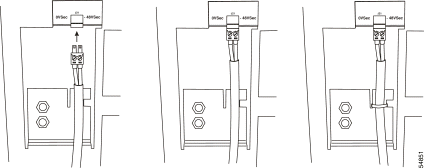
Step 6 Connect the MCU power cable to the A side of the PDP. Be sure the poles are correct.
Step 7 Insert the power cables into the connector and tighten the wire retaining screws.
Step 8 Align and connect the power cable with the PS-1 connector on the MCU backplane.
Step 9 Tie-wrap the power cable to the MCU.
Step 10 Reinsert the A-side and B-side BDB and PDP fuses.
Step 11 Verify that A- and B-side -48 VDC and -48 VDC return (0 VDC) of the MCU are connected to the proper poles at the power source. The -48 VDC return must be connected to ground the PDP on both the A and B sides.
Step 12 Verify that the incoming power is within the range of -42 VDC to -56 VDC before applying power.
 |
Note You must temporarily install the Network Control Board (NCB) and Communication Interface module (CIM) to determine if the ONS 15252 MCU has power. The LEDs on the CIM and NCB are green when the MCU has power. |
 |
Caution Always use the supplied electrostatic discharge (ESD) wristband when working with an ONS 15252 MCU. |
The ONS 15252 MCU Client Layer Interface Port (CLIP) modules and the DWDM interface port use SC fiber connectors.
 |
Note If you are using an FC connector on a CLIP port, you must use SC-FC jumpers. |
To install fiber-optic cables in the ONS 15252, connect a fiber cable with the corresponding connector type to the transmit and receive ports on the CLIP and the DWDM interface. On a CLIP module, the transmit and receive ports are located at the top of the CLIP. The receive port is located on the left and has an arrow pointing towards the CLIP label. The transmit port is located on the right and has an arrow pointing away from the CLIP label.
The DWDM transmit and receive ports are the two bottom ports located on the A- and B-side Line modules (LMs). The receive port is labeled "IN" and the transmit port is labeled "OUT."
Cisco recommends that you label the client-side transmit and receive fiber and A-side and B-side DWDM fibers at each end of the fiber span to avoid confusion with cables that are similar in appearance.
 |
Warning Follow all directions and warning labels when working with optical fibers. To prevent eye damage, never look directly into a fiber or connector. |
Step 2 Clean and inspect the client-layer optical-fiber jumper cable connectors.
Step 3 Connect the CLIP module input and output to the customer-specified point.
Step 4 Repeat Steps 1 - 3 for each CLIP.
Step 2 Clean and inspect the A-side DWDM optical-fiber jumper cable connector.
Step 3 Connect the A-side DWDM input and output to the customer-specified demarcation point.
Step 4 Repeat on the B-side LM.
This section describes how to install an assembled-to-order (ATO) ONS 15201 SCU in an equipment rack.
 |
Note You can install the ground and power cables before mounting the SCU. See the "Connect the ONS 15201 SCU to Ground" section and the "Connect Power to an ONS 15201 SCU" section for more information. |
 |
Note Clean all optical connectors and use covers to protect them. |
 |
Caution Static electricity can damage electro-optical equipment. While unpacking and handling electro-optical modules, wear a grounding wrist strap to discharge the static buildup. Grounding wrist straps are designed to prevent equipment damage caused by static electricity. Before making the necessary interconnections, connect the grounding wrist strap. |
 |
Caution The AC cord which can be ordered for the SCU is not to be used in cable management devices such as wiring ducts, plenums, or risers. For such applications, an approved AC power cord must be provided by the customer. At minimum, the AC power cord must meet all National Electrical Code (NFPA 70, National Electrical Code, 2000 Edition) and all local building code requirements. This applies to Central Offices and other buildings. |
The ONS 15201 SCU shown in Figure 3-14 is designed to be installed at ONS 15200 system client sites.
Step 2 Align the SCU with the equipment rack and cage nuts.
Step 3 Insert the SCU into the equipment rack.
Step 4 Connect the SCU to the equipment rack with four M6 screws.
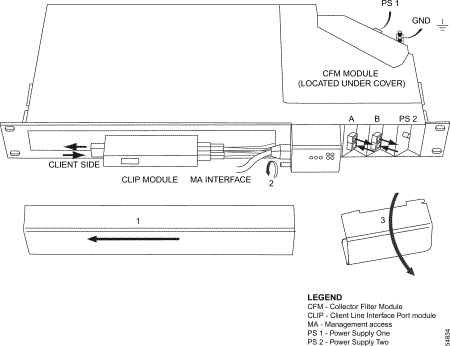
The lug on the ONS 15201 SCU ground cable can be either a single lug or dual lug as shown in Figure 3-9. You can also ground the ONS 15201 SCU using a ground strip as shown in Figure 3-10.
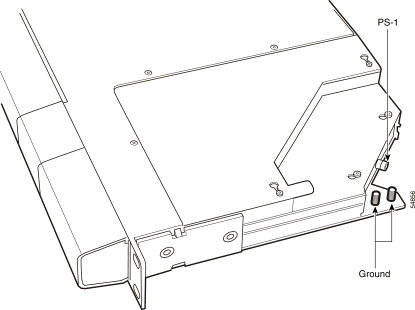
Step 2 Route the ground cable to the grounding pin where the M6 nut and washer were removed.
Step 3 Attach the ground cable to the grounding pin using the M6 nut and washer removed in Step 1.
Step 4 Firmly tighten the M6 nut on the grounding pin with a socket wrench.
Step 5 Connect the other end of the ground cable to a reliable earth ground.
Step 6 Use a multimeter that is set to read ohms to test the ground connection. The display on the multimeter should be less than 5 ohms. If the display is more than 5 ohms, tighten or reconnect the ground connection and test it again.
Step 2 Route the ground cable to the grounding pins where the M6 nuts and washers were removed.
Step 3 Attach the ground cable to the grounding pins using the M6 nuts and washers removed in Step 1.
Step 4 Firmly tighten the M6 nuts on the grounding pins with a socket wrench.
Step 5 Connect the other end of the ground cable to a reliable earth ground.
Step 6 Use a multimeter that is set to read ohms to test the ground connection. The display on the multimeter should be less than 5 ohms. If the display is more than 5 ohms, tighten or reconnect the ground connection and test it again.
Step 2 Route the ground strip to the grounding pin where the M6 nut and washer were removed.
Step 3 Attach the ground strip to the grounding pin with the M6 nut and washer removed in Step 1.
Step 4 Firmly tighten the M6 nut on the grounding pin with a socket wrench.
Step 5 Connect the other end of the ground strip to a reliable earth ground.
Step 6 Use a multimeter that is set to read ohms to test the ground connection. The display on the multimeter should be less than 5 ohms. If the display is more than 5 ohms, tighten or reconnect the ground connection and test it again.
The following procedures describe how to connect electrical power to an ONS 15201 SCU.
Step 2 Align the connector on the power cable with the PS-1 power connector on the rear of the SCU. Figure 3-16 shows the power cable connector.
 |
Note The RKMC-4 mating connector is a part of the SCU accessory kit and can be used to connect the ONS 15201 SCU DC connection to a Central Office. |
 |
Note Do not splice DC leads. |
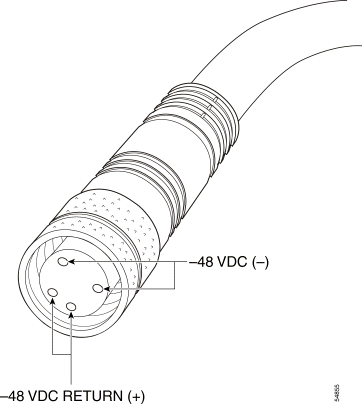
Step 3 Insert the power cable connector into the PS-1 connector.
Step 4 Hand-tighten the power cable connector to firmly mate it to the PS-1 connector.
Step 5 Connect the AC line cord on the AC-to-DC power supply to the AC power grid.
Step 2 Align the connector on the power cable with the PS-2 connector on the front of the ONS 15201 SCU. Figure 3-16 shows the power cable connector.
Step 3 Insert the power cable connector into the PS-2 power supply connector.
Step 4 Hand-tighten the power cable connector to firmly mate it to the PS-2 connector.
Step 5 Connect the AC line cord on the AC-to-DC power supply to the AC power grid.
 |
Note You can also use PS-2 as a single power-connection point. |
 |
Warning Before installing power to the ONS 15201 SCU, remove the fuses from both the A and B sides of the BDB and PDP. Failure to do so can cause injury or death. Determine the actual wire gauge based on local engineering standards and practices. |
 |
Warning Do not reverse the polarity of the PDP connections to the ONS 15201 SCU power connections. Failure to heed this caution can cause equipment damage and personal injury. |
Step 2 Connect the SCU power cable to the B side of the PDP. Be sure the poles are correct.
Step 3 Align the connector on the power cable with the PS-1 connector on the SCU backplane as shown in Figure 3-15.
Step 4 Connect the power cable to the PS-1 connector on the SCU backplane.
Step 5 Make sure the power cable connector is firmly mated to the PS-1 connector.
Step 6 Connect the SCU power cable to the A side of the PDP. Be sure the poles are correct.
Step 7 Align the connector on the power cable with the PS-2 connector on the front panel of the SCU.
Step 8 Connect the power cable to the PS-2 connector on the front panel of the SCU.
Step 9 Make sure the power cable connector is firmly mated to the PS-2 connector.
Step 10 Replace the A- and B-side BDB and PDP fuses.
Step 11 Verify that the A-side -48 VDC and B-side -48 VDC return (0 VDC) of the SCU are connected to the proper poles at the power source.
Step 12 Verify that the incoming power is within the range of -42 VDC to -56 VDC before applying power.
 |
Caution Always use the supplied ESD wristband when working with an ONS 15201. |
ONS 15201 SCU CLIP modules and the DWDM interface use SC or FC fiber connectors. If you are using an FC connector, the FC connector must be rear mounted on the DWDM side. On the client side, you must use FC-SC jumpers as an auxiliary.
To install fiber-optic cables in the SCU, connect a fiber cable with the corresponding connector type to the transmit and receive ports on the CLIP and the DWDM side or Collector Filter module (CFM). On the CLIP, the transmit and receive ports are located on the left side. The receive port is located on the bottom and has an arrow pointing towards the CLIP label.
The DWDM transmit and receive ports are located on the right side of the SCU. The A-side transmit port is located on the top left and the A-side receive is located on the bottom left. The B-side transmit is located on the top right and the B-side receive is located on the bottom right. The ports are labeled for the A side and the B side with arrows indicating which is transmit and which is receive. See Figure 3-14 for clarification.
Cisco recommends that you label the client side transmit and receive fibers and A-side and B-side DWDM fibers at each end of the fiber span to avoid confusion with cables that are similar in appearance.
 |
Warning Follow all directions and warning labels when working with optical fibers. To prevent eye damage, never look directly into a fiber or connector. |
Use the following procedure to connect the ONS 15201 CLIP to the customer-specified point.
Step 2 Clean and inspect the client-layer optical-fiber jumper cable connectors.
Step 3 Connect the CLIP module input and output to the customer-specified demarcation point.
Step 4 Repeat Steps 1 - 3 for each CLIP.
Use the following procedure to connect the ONS 15201 DWDM signal to the customer-specified demarcation point.
Step 2 Clean and inspect the A-side DWDM optical-fiber jumper cable connector.
Step 3 Connect the A-side DWDM input and output to the customer-specified demarcation point.
Step 4 Repeat on the B-side.
Normally, the ONS 15252 MCU is configured and shipped with customer-requested modules installed (assembled to order [ATO]). The ATO MCU contains a R1.0.1 shelf. See "Shelf Version Considerations" section.
Use the following module installation instructions only when an MCU must be built from scratch. Figure 3-17 shows the MCU without modules installed. If the MCU was not assembled to order, see the "ONS 15252 MCU Assembled-to-Order Installation" section for procedures to remove the crossbeam, install the fan unit, fiber organizer, ground, power, and fibers.
 |
Warning Before installing the ONS 15252 MCU, remove the fuses from both the A and B sides of the PDP. Failure to do so can cause injury or death. |
 |
Warning Touching electrical connectors or other exposed electrical circuitry inside the ONS 15252 MCU when it is energized can cause serious injury or death. |
 |
Caution Static electricity can damage electro-optical equipment. While unpacking and handling electro-optical modules, wear a grounding wrist strap to discharge the static buildup. Grounding wrist straps are designed to prevent equipment damage caused by static electricity. Before making the necessary interconnections, connect the grounding wrist strap. |
 |
Note Clean all optical connectors and keep them protected with covers prior to connection. |

Step 2 Carefully insert the NCB module in the NCB module slot as shown in Figure 3-18. Be sure the NCB module connector and the backplane connector mate correctly.
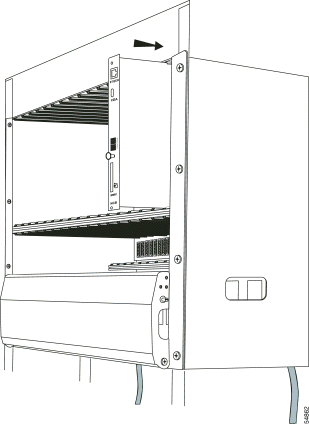
Step 3 Tighten the NCB module thumbscrews.
Step 2 Carefully insert the CIM into the slot and lower guide rail. Be sure the CIM connector and the backplane connector mate correctly.
Step 3 Use a slot or posidrive screwdriver to tighten the CIM retaining screws.
Figure 3-19 shows the CIM installed in the ONS 15252 MCU.
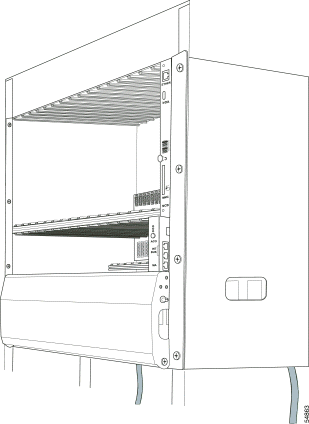
Step 2 Carefully insert the CLIP module into the slot. Be sure the CLIP module connector and the backplane connector mate correctly.
Step 3 Tighten the CLIP module thumbscrews.
Step 4 Repeat Steps 1 - 3 for each CLIP module in the ONS 15252 MCU.
Step 5 Install a CLIP module slot cover for each empty CLIP module slot.
Figure 3-20 illustrates an ONS 15252 MCU with three CLIP modules installed.
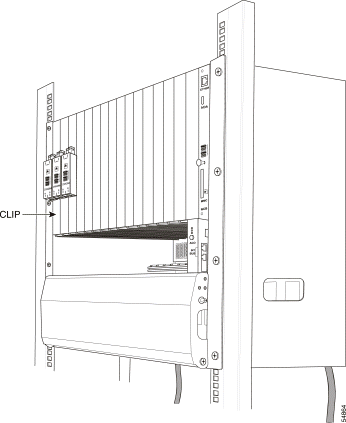
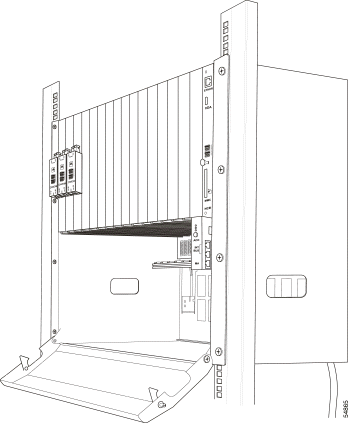
Step 2 Align the A-side LM with the far left position (if applicable) and the B-side LM with the far right position (if applicable) in the passive optical shelf. Insert them as shown in Figure 3-22.
 |
Note Normally an MCU is equipped with two LMs, but under some circumstances there may be only one LM or no LM at all. |
Step 3 Make sure the crossbar at the back of the passive optical shelf and the groove in the back of the LMs fit together.
Step 4 Push the button at the bottom front of the LMs and snap the LMs into place.
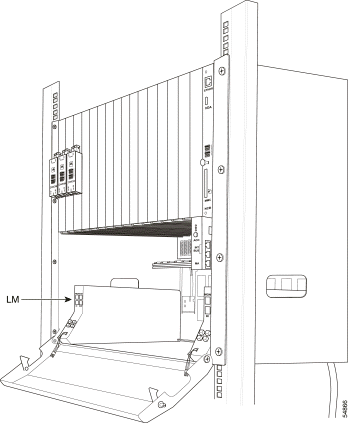
This procedure explains how to insert the Hub Filter modules (HFMs). Before connecting the HFMs, you must install the Bridge module (BM)/Termination module (TM), any Connection Module Xs (CMXs) or Connection Module Ys (CMYs), and any Dummy Filter modules (DFMs).
 |
Note The placement order of the HFM modules in the passive optical shelf must match the placement order given by the network planner. |
Step 2 Insert and slide the HFM into the passive optical shelf.
Be sure that the crossbeam in the passive optical shelf interlocks with the slot on the bottom of the HFM.
Step 3 Once the HFM is positioned in place in the passive optical shelf, push the retainer button located at bottom of the HFM front panel and snap the HFM into place.
Step 4 Repeat Steps 1 - 3 for each HFM located in the MCU passive optical shelf. Once the HFMs are installed in the passive optical shelf, the MCU should appear as illustrated in Figure 3-23.

You will install one BM, or one or two TMs, but not both the BM and TM. See the "Install the Termination Module in the ONS 15252 MCU Passive Optical Shelf" section. You can also install a combination of Connection Module X (CMX) and Connection Module Y (CMY) modules. See the "Install a Connection Module X in Two ONS 15252 MCUs" section and the "Install a Connection Module Y in Two ONS 15252 MCUs" section. Figure 3-24 illustrates a BM installation.
Step 2 Carefully slide each side of the BM into the passive optical shelf. Be sure the passive optical shelf crossbeam and the slot on the bottom of each side of the BM connect properly.
Step 3 Push the retainer button located on the bottom of each side of the BM front panel and individually snap each side of the BM into place.
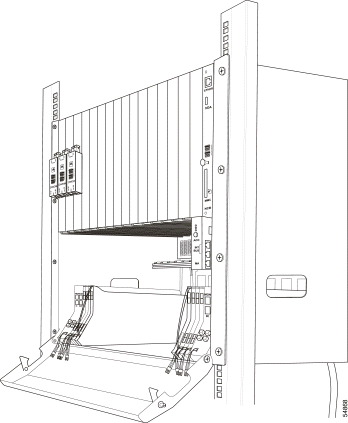
You will install a BM, or one or two TMs, but not both a BM and TMs. See the "Install the Bridge Module in the ONS 15252 MCU Passive Optical Shelf" section. You can also install a combination of Connection Module X (CMX) and Connection Module Y (CMY) modules. See the "Install a Connection Module X in Two ONS 15252 MCUs" section and the "Install a Connection Module Y in Two ONS 15252 MCUs" section.
Step 2 Carefully slide the TM into the passive optical shelf. Be sure the groove on the back of the TM connects with the passive optical shelf crossbeam.
Step 3 Push down on the TM retainer button located on the TM front panel and snap the TM into place.
Step 4 If applicable, repeat Steps 1 - 3 for the other TM.
 |
Note Use this procedure if you are using two installed assembled-to-order (ATO) MCUs rather than an MCU and SCU. |
Step 2 Put protective caps on the MU duplex connector of the last HFM.
Step 3 Remove a TM module from the passive optical shelf of the first MCU.
Step 4 Position one side of the CMX (Figure 3-25) in the passive optical shelf of the first MCU where the TM was removed.
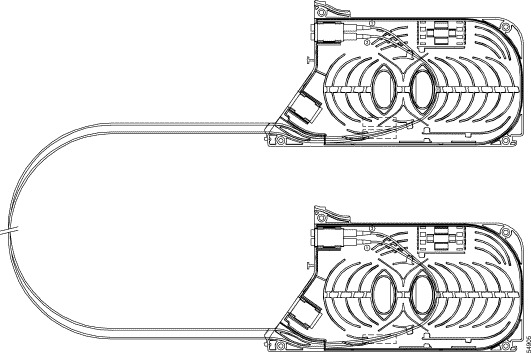
Step 5 Carefully insert the half CMX into the passive optical shelf. Be sure the groove on the back of the module interlocks with the crossbeam located in the passive optical shelf.
Step 6 Snap the CMX into place by pushing the retainer located at the bottom of the CMX.
Step 7 Remove the dust plugs located on the CMX duplex MU-MU adapter.
Step 8 Remove the fiber caps on the MU duplex connector.
Step 9 Clean, inspect, and insert the MU duplex connector from the adjacent HFM into the CMX.
Step 10 Fasten a fiber holder on the side of the passive optical shelf just outside the door.
Step 11 Guide the optical fiber cable from the CMX to the fiber holder and fasten the cable.
Step 12 Remove a TM from the passive optical shelf of the second MCU.
Step 13 Place dust caps on the connectors.
Step 14 Position the second half of the CMX in the passive optical shelf of the second MCU where the TM was removed.
Step 15 Carefully insert half of the CMX into the passive optical shelf. Be sure the groove on the back of the module interlocks with the crossbeam in the passive optical shelf.
Step 16 Snap the CMX into place by pushing downwards on the CMX front panel.
Step 17 Remove the dust caps from the duplex connector of the adjacent HFM.
Step 18 Remove the dust plugs located on the CMX duplex adapter.
Step 19 Clean, inspect, and insert the MU duplex connector from the adjacent HFM into the CMX.
Step 20 Fasten a fiber holder on the side of the passive optical shelf just outside the door.
Step 21 Guide the optical fiber cable from the CMX to the fiber holder and fasten the cable.
Step 2 Protect the optical duplex MU connector with fiber caps.
Step 3 Remove a TM from the passive optical shelf of the first ONS 15252 MCU.
Step 4 Position the CMY (Figure 3-26) in the passive optical shelf of the first MCU where you removed the TM.
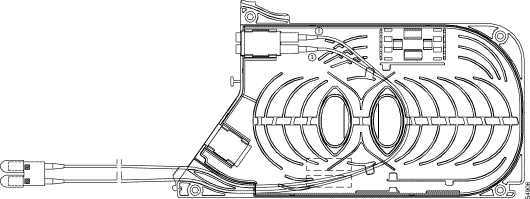
Step 5 Carefully insert the CMY. Be sure the groove on the back of the module interlocks with the crossbeam in the passive optical shelf.
Step 6 Snap the CMY into place by pushing the retainer located at the bottom of the CMY front panel.
Step 7 Remove the dust plugs located on the CMY duplex adapter.
Step 8 Clean, inspect, and insert the MU duplex connector from the adjacent HFM into the CMY.
Step 9 Fasten a fiber holder on the side of the passive optical shelf just outside the door.
Step 10 Guide the optical fiber cable from the CMY to the fiber holder and fasten the cable.
Step 11 Remove the dust plugs from the appropriate HFM.
Step 12 Remove the dust caps located on CMY optical fiber connectors.
Step 13 Clean, inspect, and insert the MU duplex connector from the CMY into the HFM in Step 11.
Step 14 Fasten a fiber holder on the side of the passive optical shelf just outside the door.
Step 15 Guide the optical fiber cable from the CMY to the fiber holder and fasten the cable.
Step 2 Slide the DFM into the passive optical shelf. Be sure the slot located on the back of the DFM aligns with the crossbeam in the rear of the ONS 15252 MCU.
Step 3 Snap the DFM into place by pressing the retainer button located at the bottom front of the DFM.
Step 4 Repeat Step 1 - 3 until the passive optical shelf is filled (Figure 3-27).
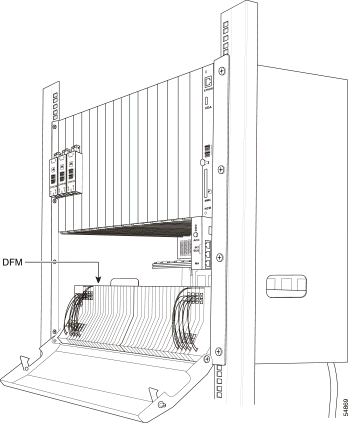
After positioning the HFMs, and installing the BMs or TMs, CMX or CMY, and DFMs, connect the passive optical shelf modules to complete the passive optical shelf installation.
Step 2 Remove the dust caps from the MU duplex connector connected to the LM.
Step 3 Clean and inspect the LM MU duplex fiber cable connector.
Step 4 Connect the LM MU duplex fiber jumper connector to the duplex MU adapter of the HFM closest to the LM.
Step 5 Remove the dust plugs from the optical-fiber jumper cable connector in the HFM.
Step 6 Remove the dust plugs from the duplex MU optical adapter in the HFM.
Step 7 Clean and inspect the optical-fiber jumper cable connector in the adjacent module.
Step 8 Connect the duplex MU optical-fiber jumper cable connector to the adjacent module.
Step 9 Repeat Steps 3 - 8 until all modules have been interconnected, ending with either a BM half, a TM, a CMX half, or a CMY.
Step 10 Repeat the procedure for both the A and B sides, if applicable, and with other MCUs, if applicable (using CMX and/or CMY).
When the modules are connected, see Figure 3-28 for an example of what the passive optical shelf should look like (with a BM module installed).
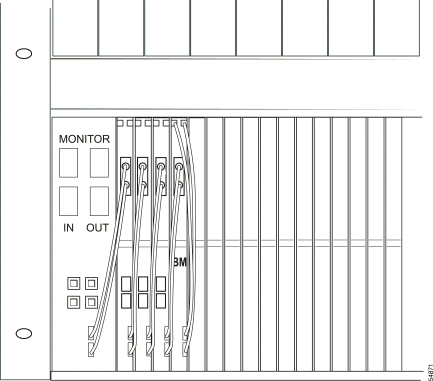
NAM modules are built per customer design specifications. If you plan to install multiple NAMs, verify that the NAM splitter ratio (50/50, 90/10, 10/90, 100/0, or 0/100) matches the requirements of the associated CLIP module.
 |
Caution In an ONS 15200 Release 1.01 shelf assembly, you must install the Release 1.01 NAM, identified by the N3 faceplate label. Placing NAMs without the N3 label into an Release 1.01 shelf may result in equipment damage. For more information about shelf versions, see "Shelf Version Considerations" section. |
 |
Note You can install Release 1.01 NAMs (identified by the N3 faceplate label) in either a Release 1.0 or Release 1.01 shelf. See "Shelf Version Considerations" section. |
Step 2 Carefully insert the NAM into the slot. Make sure that the NAM is properly inserted in the lower guide rail located in the NAM slot, and that the NAM connector and the backplane connector mate correctly.
 |
Caution When you insert the NAM, ensure that the fiber cables and connector emerging from the NAM are not pinched, which could damage the fibers. |
Step 3 Use a slot or posidrive screwdriver to tighten the NAM retaining screw.
Step 4 Remove the dust plugs from the CLIP module.
Step 5 Remove the dust cap from one of the three NAM MU connectors (for a protected channel) or one of the two NAM MU connectors (for an unprotected channel), as shown in Figure 3-29. Start with the fibers connected to the receivers, labeled either A or B.
Step 6 Clean and inspect the MU connector.
Step 7 For a protected channel, connect the NAM fiber labeled A and B to the corresponding MU optical adapters (also labeled A and B) on the associated CLIP module. For an unprotected channel, connect the optical-fiber jumper cable labeled A to the A-side MU adapter on the associated CLIP module.
Step 8 Connect the transmitter optical fiber (labeled with the serial number of the NAM) to the DWDM transmitter MU adapter on the CLIP (labeled with a down arrow). See Figure 3-30.
 |
Note The receive side of the duplex fiber connected to the HFM will be labeled with the serial number of the NAM. The transmit side of the fiber will be labeled with the transmitted power percentage. |
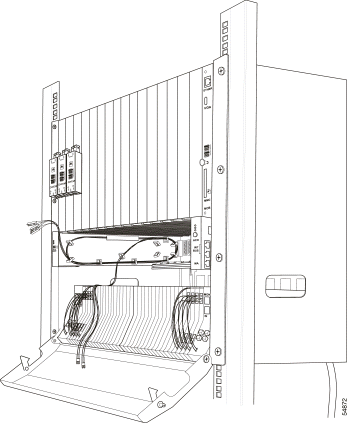
Step 9 One at a time, remove the dust caps on the connectors coming from the NAM.
Step 10 Remove the dust plugs on the associated HFM optical connectors.
Step 11 Clean and inspect the optical-fiber jumper cable connectors. Connect the duplex MU optical connectors from the NAM to the associated HFM.
Step 12 Repeat Steps 9 - 11 for protected traffic. Use the labeling on the fiber to ensure that the A side and the B side of the node are not interchanged (Figure 3-30).
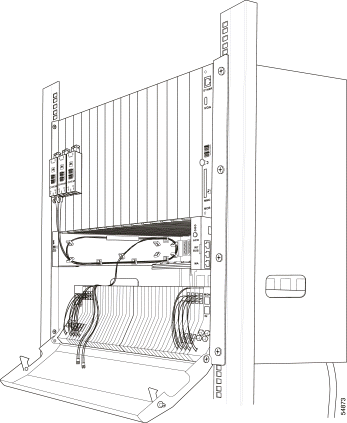
Step 13 After connecting the NAM fiber to the HFM, push the HFM slightly upward to expose the two lateral grooves on the top of the HFM.
 |
Note Do not install fiber with sharp bends. The radius of all bends must be at least 35 mm (1.4 in.). |
Step 14 Insert the fiber into the lateral grooves and snap the HFM back into place (Figure 3-31).

Step 15 For protected channels, repeat Step 13 and Step 14 for the other HFM.
Step 16 Store excess length of the fiber in the space between the NAM and the MCU passive optical shelf (shown in Figure 3-31).
Step 17 Repeat Steps 1 - 16 for each NAM in the MCU.
A Dummy Network Adaptation Module (DNAM) must be installed in all unused NAM slots.
Step 2 Carefully insert the DNAM into the slot. Be sure the DNAM connector and the backplane connector mate correctly.
 |
Caution When you insert the DNAM, ensure that the fiber and connector emerging from the adjacent NAMs are not pinched, which could damage the fibers. |
Step 3 Use a slot or posidrive screwdriver to tighten the DNAM retaining screws.
Step 4 Repeat Steps 1 - 3 for each DNAM you are installing in the MCU.
The ONS 15252 MCU with all modules installed is shown in Figure 3-32.
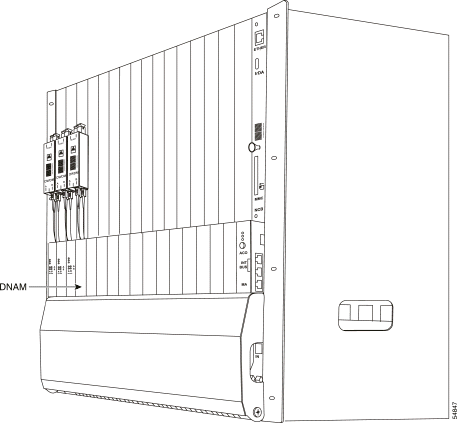
This section describes how to install an additional channel in an ONS 15200 system.
 |
Caution Installing a new channel may cause traffic interruption for some configurations. Before performing this procedure, verify that protected CLIPs are not set to switch mode "forced_a" or "forced_b." |
To add a channel, two CLIP modules are necessary at different nodes (MCU or SCU).
Step 2 Remove the blank front panel from the first slot on the right side of the installed CLIP modules.
Step 3 Align the CLIP module with the CLIP module slot.
Step 4 Carefully insert the CLIP module into the slot. Be sure that the backplane connector and the CLIP module connector are correctly mated and that no optical fiber is damaged in the process.
Step 5 Tighten the CLIP module thumbscrews.
For each fiber-protected channel installed in the ONS 15252 MCU, two Hub Filter modules (HFMs) must be installed in the passive optical shelf—one for the A side and one for the B side. Your network planner will help you determine where the HFMs should be installed for optimal performance.
 |
Note If you are installing an HFM for an unprotected channel, you do not need to install an HFM on both the A and B sides. |
Step 2 Place dust caps on the appropriate fiber connectors.
Step 3 Slide the existing HFMs and DFMs to the left to make room for the new HFM. If necessary, remove a few DFMs and replace them after completing the procedure.
Step 4 Insert the new HFM between the two modules mentioned in Step 1 .
Step 5 Disconnect the duplex fiber connector from the duplex MU adapter of the new HFM.
Step 6 Clean and inspect the fiber connectors of the new HFM.
Step 7 Connect the new HFM to the adjacent HFM.
Step 8 Remove the dust caps from the fiber connectors of the second HFM (installed in Step 1 ).
Step 9 Attach the duplex MU connectors to the new HFM.
Step 2 Place dust caps on the appropriate fiber connectors.
Step 3 Slide the existing HFMs and DFMs to the left to make room for the new HFM. If necessary, remove a few DFMs and replace them after completing the procedure.
Step 4 Insert the new HFM between the two modules mentioned in Step 1 .
Step 5 Disconnect the duplex fiber connector from the duplex MU adapter of the new HFM.
Step 6 Clean and inspect the fiber connectors of the new HFM.
Step 7 Connect the new HFM to the adjacent HFM.
Step 8 Remove the dust caps from the fiber connectors of the second HFM (installed in Step 1 ).
Step 9 Attach the duplex MU connectors to the new HFM.
Step 2 Slide the new NAM into the slot where the DNAM was removed.
Step 3 Use a slot or posidrive screwdriver to tighten the retaining screws.
 |
Note Ensure that the NAM fibers are not pinched when you insert the module. |
Step 2 Clean the NAM connector labeled A-XX. The letter A indicates the A side of the MCU, and the XX indicates the split factor of the NAM.
Step 3 Connect the fiber from the NAM to the HFM.
Step 4 Insert the fibers from the NAM into the grooves along the top of the HFM. You must move the HFM upward slightly to access the grooves at the top. Arrange the fibers from the NAM in a smooth curve on top of the passive optical shelf.
Step 5 Snap the HFM back into place after you insert the fibers.
Step 2 Clean the NAM connector labeled B-XX. The letter B indicates the B side of the MCU, and the XX indicates the split factor of the NAM.
Step 3 Connect the fiber from the NAM to the HFM.
Step 4 Insert the fibers from the NAM into the grooves along the top of the HFM. Move the HFM upward slightly to access the grooves at the top. Arrange the fibers from the NAM in a smooth curve on top of the passive optical shelf.
Step 5 Snap the HFM back into place after you insert the fibers.
Step 2 Clean and inspect the fiber from the NAM that is labeled A.
Step 3 Connect the fiber labeled A to the A-side DWDM receiver on the CLIP module.
Step 4 If the channel is protected, clean the fiber from the NAM that is labeled B.
Step 5 Connect the fiber that is labeled B to the B-side DWDM receiver on the CLIP module.
Step 6 Clean the transmit DWDM fiber (labeled with the NAM serial number).
Step 7 Connect the DWDM fiber from the NAM to the center fiber input on the CLIP module (labeled with a down arrow).
Normally, the ONS 15201 SCU is configured and shipped with the customer-requested modules already installed. Use the following module installation instructions only when you must build the ONS 15201 SCU from scratch. The following paragraphs describe how to install the individual modules in the ONS 15201 SCU.
Before beginning this section, see the "ONS 15201 SCU Assembled-to-Order Installation" section to mount the equipment in a rack, and install power, ground, and fiber.
Step 2 Locate the CFM cover lid (Figure 3-33).
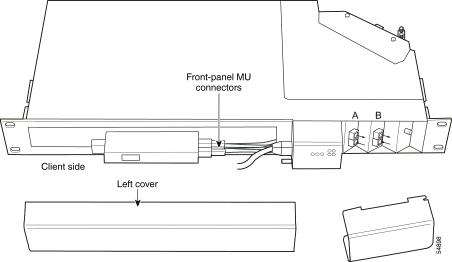
Step 3 Use a slot or posidrive screwdriver to loosen the retaining screws on the CFM cover lid. The positions of the retaining screws are shown in Figure 3-34.
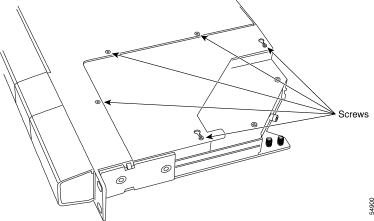
Step 4 Remove the cover lid by sliding it to the right and pulling up.
Step 5 Use a slot or posidrive screwdriver to loosen the collector cover retaining screws of the rear connector cover. Figure 3-35 shows the position of the retaining screws.

Step 6 Remove the connector cover by sliding it back and pulling up.
Step 7 Carefully insert the CFM into the SCU. Be careful not to damage the CFM fiber while inserting the module.
Step 8 Align the four holes in CFM case with the four CFM standoffs inside the SCU. When properly aligned, the CFM standoffs fit in the holes in the CFM case.
Step 9 Fasten the CFM to the CFM standoffs with four retaining screws.
Step 10 Remove the dust plugs located on the inside of the SCU SC-to-SC adapters.
Step 11 Perform the following for each SC connector on the CFM fiber:
a. Remove the dust cap from the SC connector on the CFM fiber. Do not remove the dust cap on the MU connector of the CFM fiber.
b. Clean and inspect each SC connector on the fiber.
Step 12 Connect the CFM fiber to the A- and B-side SC-to-SC adapters in accordance with the labels on the cables.
Step 13 Route the CFM MU connectors to the CLIP module area (a CLIP has not yet been installed) through the opening in the front panel of the SCU.
Step 14 Align the rear collector cover with its retaining screws.
Step 15 Install the rear collector cover by pushing down on it and sliding it forward.
Step 16 Use a slot or posidrive screwdriver to tighten the rear collector cover retaining screws.
Step 17 Align the CFM access lid with the rear collector cover retaining screws.
Step 18 Install the CFM access lid by pushing down on the lid and sliding it to the left.
Step 19 Use a slot or posidrive screwdriver to tighten the CFM access lid retaining screws.
Step 2 Carefully insert the CLIP module in the slot. Be sure the CLIP module connector and the backplane connector mate correctly and that no fibers are pinched.
Step 3 Tighten the CLIP module thumbscrews.
Step 4 Remove the MU dust cap from the MU connector on the CFM.
Step 5 One at a time, remove the dust plugs from the CLIP module optical-fiber adapter.
Step 6 Clean and inspect the connectors on the fiber.
Step 7 Connect the fiber to the CLIP module optical connectors in accordance with the labels located on the cables, starting with the receivers.
Step 8 Repeat Steps 1 - 7 for each SCU in the configuration.
You can extend the ONS 15200 system internal bus between system nodes by physically connecting control area network (CAN) bus cables between the nodes.
The two different network objects may be put together in any combination, as long as the total CAN bus length is less than 22 meters and the following rules are met:
 |
Note One-meter (3.3 ft.) and five-meter (16.4 ft.) bus cables are available from Cisco (P/N 72-2654 and 72-2790, respectively. |
Route the bus cables from one node to another and connect them to the INT BUS connectors.
The different CLIP modules of an ONS 15252 MCU—as well as an NCB module—are connected with a CAN bus. This data bus can be extended over several co-located network elements (ONS 15252 MCUs or ONS 15201 SCUs) to a larger logical unit. In the SCU, the same data bus is used, and normally all ONS 15200 equipment located at one site will be connected on one CAN bus. Communication between the two endpoints of a channel is carried optically over a proprietary protocol, QPP. Any CLIP module that will be controlled by an NCB module must not be more than two optical communication channels away from that NCB module.
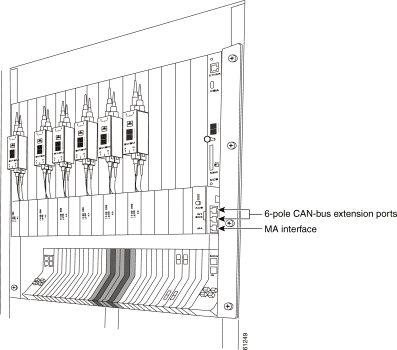
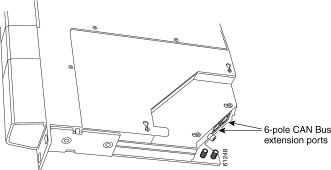
When several MCUs are joined on a single CAN bus, they must have different backplane jumpers. The backplane jumpers are located between Slots 15 and 16 of the MCU backplane (Figure 3-38).
When leaving the factory, the two jumpers are set to 00. When adding MCUs to a single CAN bus, reset these jumpers to 01, 10, and 11. In an MCU with backplane jumpers set to 11, only slot positions 1 through 12 can be used because the system will try to assign identical DCN addresses to all CLIPs in Slots 12 through 16. Each CLIP must have a unique DCN address.
 |
Note Before changing the MCU backplane jumper settings, turn the system power off. After you have changed the settings, turn the power back on. When the you restart the power, the system assigns each CLIP a new unique DCN address. |
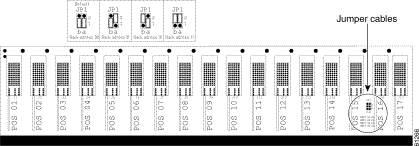
![]()
![]()
![]()
![]()
![]()
![]()
![]()
![]()
Posted: Sat Jan 5 12:56:58 PST 2002
All contents are Copyright © 1992--2002 Cisco Systems, Inc. All rights reserved.
Important Notices and Privacy Statement.